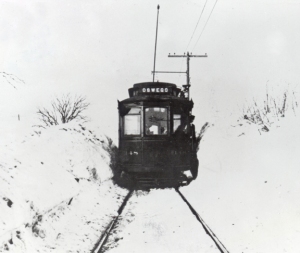My friend of some 40 years and former boss sent a photo to me the other day that was, in turn, sent to him via this wonderful communications medium we call the Internet.

The author, seemingly mezmerized by the black and white screen on his Mac in the spring of 1989, as big changes were happening in journalism.
There I was, perched at my borrowed desk at the Kendall County Record office in Yorkville on a Wednesday morning in 1989, running out copy. My trusty TRS-80 laptop is on the desk, connected with a null modem to the 512k Mac that we used to print out copy on the LaserWriter printer. While we knew we weren’t exactly at the cutting edge of news biz technology, we weren’t too far removed during that era when the Mac revolutionized how newspaper production.
By that time, we’d gone through a number of technological changes as the old Linotype hot type technology was left behind in favor of computerized type setting. But even those earlier typesetting reiterations were light years ahead of where newspapers started out when Kendall County was a youngster.
The first county newspaper was the Kendall County Courier, established by Hector S. Humphrey in 1852 at Oswego, then the Kendall County Seat. A native New Yorker like so many early pioneers, after earning his journeyman printer’s status, Humphrey headed west in 1848 to boisterous, fast-growing Chicago. After a few years there, he moved farther west to Naperville before deciding to start the Courier at Oswego.
During that era, printers need a variety of skills. Presses were operated by hand, producing one sheet at a time. Type was ordered in full sets from type foundries and graphics were set with individual woodcuts. Type cases were arranged so typographers stood, and pulled type from either the lower cases (with lower case letters) or the cases up high with capitals (upper case letters). Individual letters, punctuation marks, and spaces (which varied from N to M spaces—the width of a capital N or M) were set by hand in frames. When the setting was done, the frames were locked and a proof page was run off for the proofreader.

Converting horsepower to mechanical power allowed print presses at small country weeklies to become much more efficient.
The first innovations in newspaper printing technology came with powered presses. Originally, presses were operated by apprentice printers or “printer’s devils,” who had to crank them by hand. Small country weeklies then moved to presses operated by a horsepower—the power provided by a horse plodding around a circle, the rotating arm providing power, or on a treadmill. In town, a treadmill horsepower was probably used.
On Feb. 15, 1883, publisher John R. Marshall wrote in the Kendall County Record that: “The Record office met with a catastrophe Wednesday morning. The snow on the horsepower shed gathered weight from the rain Tuesday night and the roof came down with a crash, making a ruin for awhile. The old power was badly busted and we haven’t money enough to buy a steam engine.”
But Marshall finally did find the money and by the late 1880s, the horsepower had been retired in favor of a small steam engine.

Linotype pretty much had the typesetting market to itself for years, only displaced when computerized cold type typesetters were perfected.
The next innovation was setting type by machine. Linotype was the leader in that field for the next several decades. Sitting at a giant, seemingly Rube Goldberg device, the Linotype operator used a keyboard whose keys were mechanically connected to the machine’s works. Each key struck caused the machine to cast a letter, space, or punctuation mark on the fly. At the Record, the first typesetters were powered by the same steam engine that powered the press, but in 1907, Marshall installed electric motors to run both machines. Originally, a gasoline burner melted the lead for typesetting, but in 1913 Western United Gas & Electric extended municipal gas lines to Yorkville from the company’s plant in Aurora, and the Record reported: “The Linotype machine in The Record office is now equipped with a gas burner to heat the metal for the casting of slugs. This new attachment does away with a gasoline burner.”
Off-set printing came in next, with pages being “burned” onto aluminum plates that never really touched newsprint. Instead, the plate was wrapped around a roller. When the roller turned, it picked up ink from an ink roller and the image was transferred to yet another roller, and THAT’s the roller that actually printed the image on the paper.
Then in the 1960s Compugraphic introduced computerized typesetters priced for smaller weeklies. With these gizmos, type was set on strips of photographic paper that spooled out of the machines. The strips were run through a waxer (which applied a thin layer of wax on—we fervently hoped—the blank side of the strip of copy) and then were pasted onto blank layout pages. Input for these cold type (as opposed to the old Linotype hot type machines) typesetters was either through a built-in keyboard, or a punched paper tape. The tape was produced by a sort of computerized terminal that offered a single line of copy viewable as the typesetter worked.

We produced yards of paper tape back in the early 1980s that were then run through photo typesetters, which spit copy out to be pasted up.
That’s how the Ledger-Sentinel’s type was set when the paper was formed in Oswego by the merger of the old Fox Valley Sentinel and the Oswego Ledger in the summer of 1980. We typed copy on yellow foolscap using electric typewriters, edited our copy, and then passed it on to our faithful typesetter, Dorothy Kellogg, who transferred it to yards of paper tape. The rolls of tape were taken to the print shop in Yorkville and run through the typesetters, proofed and changes carefully pasted in place using the trusty waxer again.
The next big thing was the Macintosh revolution that allowed anyone with room for a Mac and a LaserWriter to start their own paper. No more paper tape, odd third-party typesetting terminals, or phototypesetters. Instead, copy could be printed on plain paper, waxed, and pasted up. Instead of ordering sets of type from foundries, they came on floppy discs from some of the old names in typesetting and typography.

The TRS-80 Model 100 became a ubiquitous reporter’s tool in the late 1980s until replaced by early, far more useful, laptop computers.
Those early Macs were expensive, though, so we compromised by equipping our reporters with the then-new TRS-80 laptops. They were crude machines, but far better than typewriters. Copy could be edited—though it was a bit of a struggle since only about four lines of type were visible at a time and no spell-check was available. Every evening, we’d connect the TRS-80s to the phone line and send our copy down to Yorkville via the machines’ built-in 300 baud modems, where it was downloaded and formatted on Macs. Then on Wednesday we’d all gather at the print shop in Yorkville to do paste-up and download all the remaining copy to the accompaniment of the low rumble of the web press on the first floor spitting out copies at a rate that would have made old J.R. Marshall green with envy.

The early Macintosh was a revelation; it offered the opportunity for just about anyone to start their own newspaper. The revolution Steve Jobs started in 1984 continues at an ever-faster pace today.
Which is what I’m doing in that 1989 photograph. It wasn’t too long afterwards that we got Macs at the Ledger-Sentinel office so we could create an office network, edit each other’s copy, and send the results down to Yorkville on much faster modems.
By the time I retired from the news biz in 2007, we were emailing copy via the Internet; no more dial-up modems required. And nowadays, paste-up is long gone, too. Pages are laid out using QuarkXpress, and are sent through a gizmo that turns the files directly into off-set printing plates.
Newspaper offices used to be notable for their noise: the machine noise of the Linotype, then the tapping of typewriters and the low hum of photo typesetters. Now, they’re fairly quiet places with only the tapping of keys on computer keyboards audible. But while the technology has seen great changes during the past few decades, the goal of journalists is still the same: Get the news and print it. While the big media folks seem to be having some problems figuring out exactly what’s news and what facts are concerning the big issues of the day, real journalism is still being committed at the local, weekly level.
And long may it be so.








